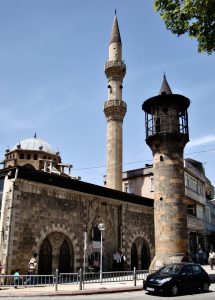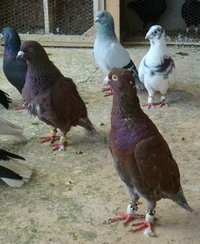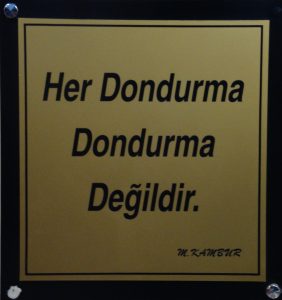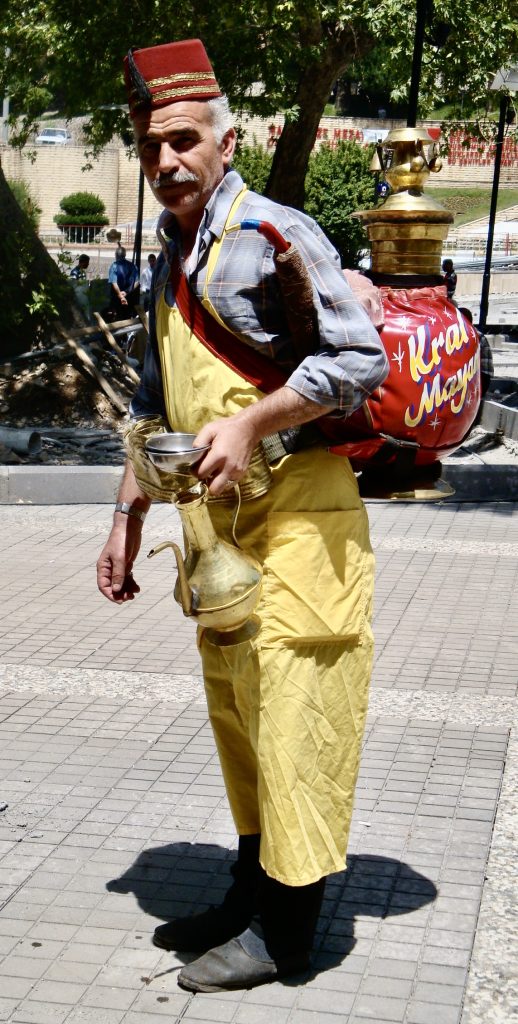“Heroic” Maraş Population: 550,000
Old names: Marasi, Germanicia (Roman)
***Kahramanmaraş was at the epicentre of one of the 2023 earthquakes and suffered terrible damage. Much of what is written here is therefore likely to be historic.***

Due north of Gaziantep, Kahramanmaraş is not, at first sight, an especially alluring city. On the surface Maraş (the “kahraman” is an addition to its name which I’ll come to later) looks like a solidly concrete-built modern conurbation, its high street dominated by a business centre that looks like an outsize, elongated Rubik’s cube.
But first impressions can be deceptive, and this is certainly one of those occasions since the city turns out to have a well-hidden old quarter where restoration became all the rage in the 2010s.
Don’t leave town without trying:
- Maraş dondurması (Maraş ice-cream), a sweet so thick that it can be hung up or cut with a knife and fork and which is traditionally solid with great theatricality
- meyankökü, a tart licorice drink that is a very acquired taste despite claims that it’s a natural Coca-Cola.
Backstory
It’s thought that Maraş was originally the site of an Assyrian town called Marasi before becoming the capital of a late Hittite kingdom. That settlement was destroyed by the Assyrian king Sargon II in the eighth century BC, and Maraş doesn’t reappear in the records again until the first century AD when the site at the foot of Ahir Dağı (Stable Mountain) crops up as the Roman town of Germaniceia.
Its location at the junction between Europe and the Middle East ensured that it then seesawed back and forth in ownership between the Byzantines and the Arabs before finally falling to the emperor Nicephorus Phocas in 962 and then staying in Byzantine hands through much of the 11th century.
But as the threat from the Arabs ebbed, so that from the Selçuk Turks flowed, and soon what is now Maraş was overrun with Armenians fleeing in the face of their advance. It quickly became the centre of a mini-kingdom established by a man called Philaretes which eventually absorbed Malatya, Edessa (Şanlıurfa), and Antakya before being overthrown by the Selçuks.
Even then poor old Maraş could not be allowed to rest in peace. Instead the Crusaders grabbed it and returned it to the Byzantine emperor Alexius I Comnenos. Eventually it was absorbed into the Armenian Kingdom of Cilicia with its capital at Sis (modern Kozan). Then came the Mamluks and the Mongols, and finally, in 1516, the Ottomans under Sultan Selim I.
At last Maraş was able to settle down to a couple of centuries of stability which came to an end in 1832 when it was briefly a fiefdom of the Egyptian İbrahim Paşa.
In the chaos following the First World War and the collapse of the Ottoman Empire it fell first to the British and then to the French. But by then Maraş had learnt its lesson and its citizens put up such stout resistance to the foreign occupiers that the epithet “kahraman (heroic)” was subsequently added to its name.
 Around town
Around town
With so much history behind it, it seems at first a little odd to see so little evidence of the past in the modern streets.
The thing to do is to head straight for the statue that commemorates the Sütçü İmam incident when a local imam attempted to defend the honour of local women against forces occupying the city in 1920.
Nearby is the Ulu Cami (Great Mosque) at the foot of a hill which carries the remains of a Byzantine castle rebuilt in Ottoman times. Dive into the back streets around here to discover the old Maraş that is initially so conspicuous by its absence.
The Ulu Cami dates back to 1502, which means that it just predates the Ottoman occupation. Its most interesting feature is a minaret topped off with a little cap like a cut-down version of the witch’s hat on top of İstanbul’s Galata Tower. This is just the most obvious of a set of mosques – the Nur, the Şekerli, the Arasa, the Boğaskezen and the Hatuniye – with minarets designed in just the same way and that link Maraş architecturally with Syria.
Across the street stands the small Taş Medrese, a medieval Koranic school. Cutting uphill beside the mosque you’ll come to Maraş’ secretive old quarter which is filled with crumbling Ottoman houses, most of them partially obscured by 20th-century breezeblock and concrete additions.

Keep walking and you will eventually stumble upon the restored Dedeoğlu Konağı. Right beside the Hatuniye Cami you will also spot an absolutely magnificent house whose ground-floor is so solidly built from stone as to resemble a fortress but whose upper wooden storey boasts a glorious curving balcony overlooking the mosque.
This is a part of town where life proceeds at a slow and traditional pace. Across the road from the Hatuniye Cami you will find the local pigeon-fanciers’ shop where birds are decked out in cute little ear-rings and anklets just like their better-known cousins in Urfa.
Down by the Ulu Cami şerbet-sellers in colourful costumes stroll around with large metal containers strapped to their backs and wearing heavy metal belts studded with containers for glasses. But where they have their eyes firmly fixed on the tourist dollar, here in Maraş it’s the locals who make up the enthusiastic clientele for these purveyors of meyankökü.
It won’t be long before you hear a tap-tap-tapping that will lead you into the old bazaar where men still make a living beating out copper and tin alongside others who fashion elaborate modern sandıks (dowry boxes) and yemeniliks (headscarf boxes) from walnut.
This is a great place to shop for all things Turkish and non-touristy, and while you make your way around you will also be able to snap up the odd local snack such as a piece of sweetened katmer, a type of flat bread vaguely reminiscent of an Indian paratha.
Sleeping
Hotel Belli Comfortable city-centre hotel with decent service convenient for exploring the old part of town. Tel: 0344-223 4900
Ramada Hotel With your own car you might want to seek out the greater modernity and comforts of this chain hotel away from the centre on the Kayseri road. Tel: 0344-211 1010
Yimpaş Hotel Tel: 0344-224 0000
 The ice-cream story These days you don’t have to be in Maraş to be accosted by men in colourful, glittery costumes who jangle bells as you pass their stall, then scoop out from their tubs an ice-cream with the texture of plasticine. This, as they will tell you, is the real deal – Maraş dondurması, or ice-cream as originally made in Kahramanmaraş.
The ice-cream story These days you don’t have to be in Maraş to be accosted by men in colourful, glittery costumes who jangle bells as you pass their stall, then scoop out from their tubs an ice-cream with the texture of plasticine. This, as they will tell you, is the real deal – Maraş dondurması, or ice-cream as originally made in Kahramanmaraş.
For many years the Yaşar Pastanesi on Trabzon Caddesi, first opened in 1850, held a monopoly on sales of dövme dondurması (beaten ice-cream), a confection made from the milk of sheep that had feasted on the orchids and wild flowers of Ahir Dağı and that was so thick that it needed to be eaten with a knife and fork.
Photographs on the wall of the Yaşar still show the rich and famous being treated to this delicacy, but times have moved on, and now every other shop seems to be getting in on the act, even selling the ice-cream in hediye (gift) packets said to be good for 72 hours in transit.
There are frequent minibuses from Osmaniye and Gaziantep to Kahranmaraş and less frequent buses to Adiyaman for Kahta and Nemrut Dağı.
Day trip destinations


